 The first thing all three of these incenses have in common is that the contact information is the same post office box in the Mysore District of Karnataka State in India even though all the incenses are presented fairly differently. The second thing is that all three of these Tibetan style incenses have major perfume presences and in that sense are actually a completely different family of incenses than your normal Tibetan, Nepalese or Bhutanese incense. I can’t tell if these are legitimate monasteries or if there’s one company at work here designing these incenses to look authentically Tibetan but their similarities are too strong to discount them all from being a line designed by a Mysore area perfumer/incense factory. Some research on the PO Box shows that a number of Tibetan monasteries use it, and I’m assuming their products all come out of this same, for lack of a better word, “clearinghouse.”
The first thing all three of these incenses have in common is that the contact information is the same post office box in the Mysore District of Karnataka State in India even though all the incenses are presented fairly differently. The second thing is that all three of these Tibetan style incenses have major perfume presences and in that sense are actually a completely different family of incenses than your normal Tibetan, Nepalese or Bhutanese incense. I can’t tell if these are legitimate monasteries or if there’s one company at work here designing these incenses to look authentically Tibetan but their similarities are too strong to discount them all from being a line designed by a Mysore area perfumer/incense factory. Some research on the PO Box shows that a number of Tibetan monasteries use it, and I’m assuming their products all come out of this same, for lack of a better word, “clearinghouse.”
And so to take a quick tangent (if you don’t want to read some of this, just drop to the next picture) because it’s a subject that comes up so a lot, what do we mean by perfumed? Natural? Organic? Synthetic? First of all, I’m (obviously) not a chemist or laboratory expert and the incenses we evaluate here, at best, come with an incomplete list of ingredients and/or various promises of how natural or cruelty free or vegan or whatever the box or marketing material contains. It probably should be understood that these various descriptions tend to be from a give and take between manufacturers and importers. From the perspective of ORS and the things we have learned over the year (mostly rumors and conjecture to be honest), we think it’s as close to certain as we can be that Indian incenses, especially over the last few decades where famous natural scents have been severely depleted, use other, largely unnamed ingredients meant to duplicate natural scents. And we believe that when incense companies say “natural” they may not mean it in the same way Americans do. Say there are naturally produced chemicals from organic materials that are altered in a laboratory to imitate a particular scent, is that something you would consider actually natural or not? I think the concern is generally whether synthetic chemicals (or especially toxic or dangerous chemicals) are used in an incense, and I would think in most Indian incenses, even possibly in some incenses where the word “natural” is used, it’s quite possible, even entirely likely, synthetic chemicals are used to some extent. But again without test results about the only thing I can trust is my natural reaction to an incense that is making me uncomfortable.
A selling point on any incense box isn’t going to be “synthetic chemicals used” because absolutely no one would be buying it. Lhochok Palgeri is described on the box as a “Superior Quality Incense.” Well maybe, but that’s a marketing tool right? It’s also described as “A Tibetan incense purely handmade with authentic herbal ingredients, carefully sourced and handpicked specifically from the sacred Himalayan Ranges.” I don’t see any reasons to believe any of this is untrue but what it’s not saying might be even more important, especially when you get a whiff. Because there’s a huge difference between any incense that does and doesn’t use oils or perfumes of some sort and it’s completely obvious these are being used if you can take the fresh batch of unburned incense and give it a sniff or two. If it’s popping with scent (or smells kind of wet) then oils/perfumes are being used. However, the presence of oils doesn’t necessarily tell you what kind of oils they are, they could be anything from a mix of natural essential oils to synthetic perfumes and all points in between. I’d imagine much of this is based on expense. Lots of essential oils are cheap and probably easily enough used in their natural state. So how do we know what is what? Well for the most part we don’t know. I think many of us who have used incense for a while evaluate the possibility by allergic reactions. Does the aroma get you stuffy or sting your eyes or maybe even make you nauseous? Well some natural ingredients probably do that too, but if your body is telling you all those things then you probably don’t want to keep using them whatever is the case. Think of backflow cones, and the smell that comes from adding chemicals to make the smoke sink instead of rise. How is that making you feel?
And to get back to Lhochok Palgeri, the statement about authentic herbal ingredients can be true while they’re adding synthetic ingredients or chemicals too. Mark my words though, I don’t know if that’s true and if I’m actually being objective, I can literally only guess, but again, it’s often what is not said, not what is. Even when the company may be telling you something, hell even when I am so close to certain on something, I’d still have some room in my head for the possibility it’s not true. I’m afraid unless I see some lab or chemistry report of an incense handled by a trained scientist in aromatics with a list of ingredients, I’m always going to be more reserved in my opinion and not pass through comments that have their facts mixed up. So enough about that…
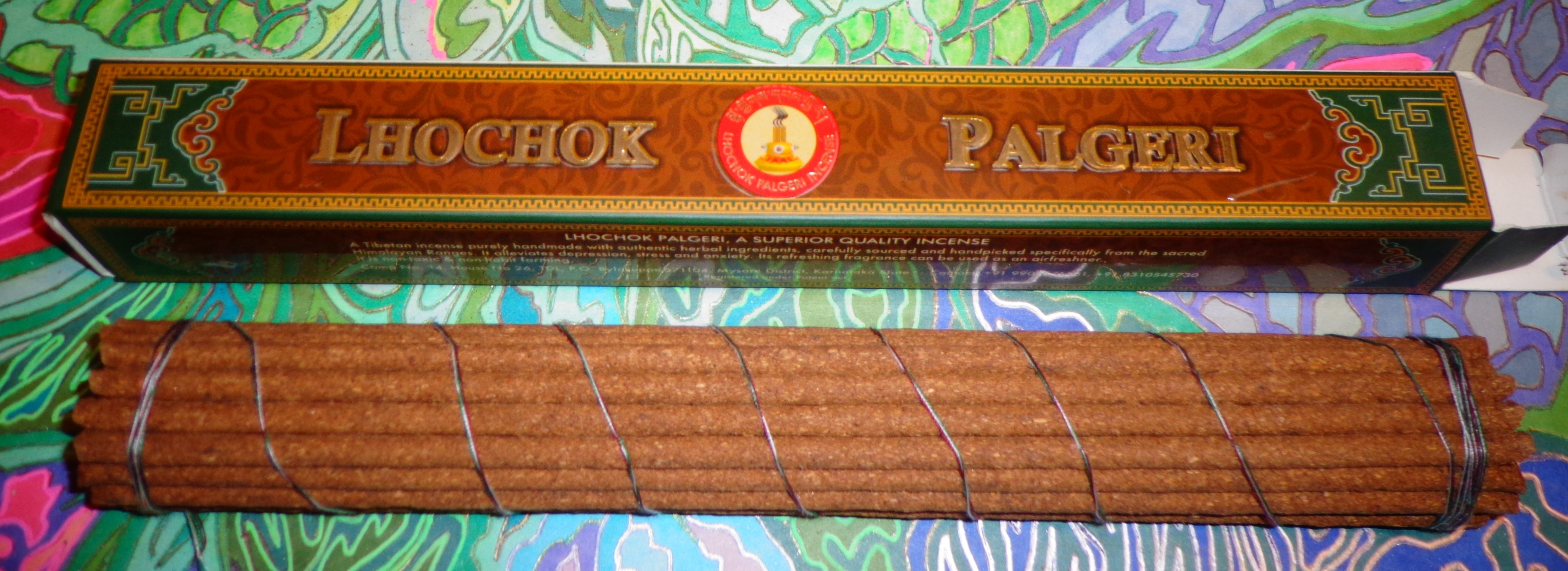 OK now I am really back to Lhochok Palgeri, but I really set this all up because it came in an order from Monkcense, a nice little Etsy shop with a whole bunch of incenses I had not heard of before and the owner was really kind enough to send along a whole bunch of inch long samples of other incenses they carried and after trying over half a dozen of them, I realized they were all like the three incenses I’m going to review here, in fact with samples so short a lot of them actually smelled exactly the same to me. They feel at base traditional Tibetans but they have been practically steroid-infused with some really strong perfume/oil mixes and I was surprised to find that at least so far while I didn’t consider these mixes bad on the face on it, sometimes they aligned really well with the bases and sometimes they set off a whole lot of pinging and ponging. And so I have coined all these as “perfumed traditionals.” Lhochok Palgeri is as good as any other incense to start with in this vein, in the sense that absolutely no ingredients are listed here. This incense actually remind me mostly of the kinds of Indian charcoals that will have mixes that blend florals, cooking herbs and all sorts of other things into incenses that are really hard to parse. Burning this I’m reminded of like dill or celery seed combined with something evergreen and some fancy floral all at once. Some of the aspects I’m not even sure I’ve smelled in a Tibetan incense before, so it starts off being really fascinating. But my gut feeling is strongly wondering what I’m going to feel like after 5 or 10 sticks of this? Is it going to get under my skin or start to irritate me? Because it feels like almost everything in this is dialed up to the loudest volume possible, like nothing was structured to act as foreground or background so it kind of rolls up into white noise. And if you use ash to burn these, these incenses will sometimes transfer this massive aromatic punch to your ash. So despite that this is an original mix, I feel with every stick it’s just a little too powerful or overwhelming, even more so than some of the loudest Indian charcoals and masalas.
OK now I am really back to Lhochok Palgeri, but I really set this all up because it came in an order from Monkcense, a nice little Etsy shop with a whole bunch of incenses I had not heard of before and the owner was really kind enough to send along a whole bunch of inch long samples of other incenses they carried and after trying over half a dozen of them, I realized they were all like the three incenses I’m going to review here, in fact with samples so short a lot of them actually smelled exactly the same to me. They feel at base traditional Tibetans but they have been practically steroid-infused with some really strong perfume/oil mixes and I was surprised to find that at least so far while I didn’t consider these mixes bad on the face on it, sometimes they aligned really well with the bases and sometimes they set off a whole lot of pinging and ponging. And so I have coined all these as “perfumed traditionals.” Lhochok Palgeri is as good as any other incense to start with in this vein, in the sense that absolutely no ingredients are listed here. This incense actually remind me mostly of the kinds of Indian charcoals that will have mixes that blend florals, cooking herbs and all sorts of other things into incenses that are really hard to parse. Burning this I’m reminded of like dill or celery seed combined with something evergreen and some fancy floral all at once. Some of the aspects I’m not even sure I’ve smelled in a Tibetan incense before, so it starts off being really fascinating. But my gut feeling is strongly wondering what I’m going to feel like after 5 or 10 sticks of this? Is it going to get under my skin or start to irritate me? Because it feels like almost everything in this is dialed up to the loudest volume possible, like nothing was structured to act as foreground or background so it kind of rolls up into white noise. And if you use ash to burn these, these incenses will sometimes transfer this massive aromatic punch to your ash. So despite that this is an original mix, I feel with every stick it’s just a little too powerful or overwhelming, even more so than some of the loudest Indian charcoals and masalas.
 Now while Namdroling Monastery Tibetan Herbal Incense is purportedly from a monastery it holds the same postal office box that Lhochok Palgeri has; however, it does look like this monastery is in the same district. This time ingredients are listed: juniper, liquorice, agarwood, myrrh, cinnamon, cardamom, cloves, spikenard, nutmeg, saffron, vetiver, kusum flower, sandalwood powder, and resins. What I noticed right away is the spices like cinnamon, cardamom, cloves and nutmeg were all much more highly concentrated in this than they usually are in a Tibetan incense, most of these are clearly carried on a wave of perfume oil. I don’t imagine that any of these ingredients are cost prohibitive to fake so the strong spice front seems pretty genuine to me, and it is actually quite nice. But even if this oil is natural or mostly natural it is still loud as hell and so up front that it practically lives in your nostrils. And this is coming from someone who has been incense saturated for decades at this point and actually doesn’t mind loud Indian masalas that often overwhelm a good fraction of the community. Think of the kind of cinnamon you’d get from a concentrated bottle of essential oil and imagine firehosing it in all directions. OK I exaggerate of course, but one good way of telling you how powerful this is is lighting two sticks of it at once. Anyway, the point of this once again is subtlety is lost here, or perhaps it is if you don’t have a room big enough for this to dissipate and spread out. And you really need that for an incense so heavy in spice. And believe me I want to like this and actually do on some level, but the perfume is so intense here it almost smells like charry wood or some type of overheating. But after Lhockok Palgeri, it’s hard to really look it at the same as the dozens of other actual Tibetan monastery incenses that, if they use oils at all, do so in a measured way that doesn’t overtake anything going on in the middle or bottom. It feels like there’s a company at play that creates these for monasteries or, well, yeah I won’t go there…
Now while Namdroling Monastery Tibetan Herbal Incense is purportedly from a monastery it holds the same postal office box that Lhochok Palgeri has; however, it does look like this monastery is in the same district. This time ingredients are listed: juniper, liquorice, agarwood, myrrh, cinnamon, cardamom, cloves, spikenard, nutmeg, saffron, vetiver, kusum flower, sandalwood powder, and resins. What I noticed right away is the spices like cinnamon, cardamom, cloves and nutmeg were all much more highly concentrated in this than they usually are in a Tibetan incense, most of these are clearly carried on a wave of perfume oil. I don’t imagine that any of these ingredients are cost prohibitive to fake so the strong spice front seems pretty genuine to me, and it is actually quite nice. But even if this oil is natural or mostly natural it is still loud as hell and so up front that it practically lives in your nostrils. And this is coming from someone who has been incense saturated for decades at this point and actually doesn’t mind loud Indian masalas that often overwhelm a good fraction of the community. Think of the kind of cinnamon you’d get from a concentrated bottle of essential oil and imagine firehosing it in all directions. OK I exaggerate of course, but one good way of telling you how powerful this is is lighting two sticks of it at once. Anyway, the point of this once again is subtlety is lost here, or perhaps it is if you don’t have a room big enough for this to dissipate and spread out. And you really need that for an incense so heavy in spice. And believe me I want to like this and actually do on some level, but the perfume is so intense here it almost smells like charry wood or some type of overheating. But after Lhockok Palgeri, it’s hard to really look it at the same as the dozens of other actual Tibetan monastery incenses that, if they use oils at all, do so in a measured way that doesn’t overtake anything going on in the middle or bottom. It feels like there’s a company at play that creates these for monasteries or, well, yeah I won’t go there…
 The same PO box is listed for Thekchenling Monastery Incense as well; it is apparently marketed by Sera Thekchenling Lachi Society. Which is perhaps a little odd when you consider that Sera Thekchenling Monastery is in Lhasa, Tibet; it is apparently one of the biggest monasteries in Lhasa and something of a tourist stop. But as the incense is still part of this family of incenses with the perfumes, it is certainly curious about how all this works. Unfortunately, there doesn’t appear to be an ingredient list on this one, but it is definitely quite distinct from the Namdroling. Thekchenling Monastery Incense goes for what feels like an herbal-floral mix, one not terribly far off the Lhachok Palgeri. There are some obvious woods on the bottom, but just like with the other two, everything else in the mix feels pushed up front due to the weight of the oil mix. Because of this it’s very hard to parse anything specifically. My thoughts were sort of like somewhere between a ganden grass/mild cooking herb meets a very perfumed white flower floral mix. In fact what strikes me as so odd about these three incenses is the mix of traditional and modern. I should also mention that after this went out I could still smell the afterscent of this incense, even after giving some time in between sticks, louder than the one I was trying to remember. That is a lot of oil if it’s going into the ash and staying there.
The same PO box is listed for Thekchenling Monastery Incense as well; it is apparently marketed by Sera Thekchenling Lachi Society. Which is perhaps a little odd when you consider that Sera Thekchenling Monastery is in Lhasa, Tibet; it is apparently one of the biggest monasteries in Lhasa and something of a tourist stop. But as the incense is still part of this family of incenses with the perfumes, it is certainly curious about how all this works. Unfortunately, there doesn’t appear to be an ingredient list on this one, but it is definitely quite distinct from the Namdroling. Thekchenling Monastery Incense goes for what feels like an herbal-floral mix, one not terribly far off the Lhachok Palgeri. There are some obvious woods on the bottom, but just like with the other two, everything else in the mix feels pushed up front due to the weight of the oil mix. Because of this it’s very hard to parse anything specifically. My thoughts were sort of like somewhere between a ganden grass/mild cooking herb meets a very perfumed white flower floral mix. In fact what strikes me as so odd about these three incenses is the mix of traditional and modern. I should also mention that after this went out I could still smell the afterscent of this incense, even after giving some time in between sticks, louder than the one I was trying to remember. That is a lot of oil if it’s going into the ash and staying there.
So ultimately these are not incenses I would really classify as monastery incenses or even traditionals. Some of what I’m smelling I would be hard pressed to be found in an old recipe, there is just too much in the way of the kind of modern floral scents you might find in Shoyeido or Nippon Kodo perfumed sticks for that. In a way the fusion is definitely kind of interesting, but I also find it pretty exhausting, loud and relentless. Some of this is just the sheer power of the incenses, but it’s also this sort of weird conflict between pretty florals and the rugged herbal/woody catalog of most Tibetan incenses. I’m always left questioning whether all this oil on top is drowning anything out as well. Ultimately by the time one of these long sticks burns down I feel that it’s kind of worn out its welcome, I’m starting to pay more attention to how I’m feeling than the aroma itself. What this meant for me is the dozen or more incenses in this vein I tried samples of I’m not likely to buy full boxes of or review because the fatigue would ultimately be grinding. Use sparingly if you try them and experiment first with how much space you have as these are likely to be too much for a lot of ORS readers.
 It has been a really long time since I did new reviews of Nepali or Tibetan-style Indian incenses. In the current era I don’t know if there is one dominant shopping point for these types of incenses like there was when Essence of the Ages was active, although Hither & Yon in Hawaii is a good source for lines like Dhoop Factory and you can usually find a lot of the more common Nepali incenses through places like Incense Warehouse. The problem, which is something I don’t think you find in actual Tibetan incenses, is there are a lot of poor Nepali incenses. When I explored them back in the 00s I ended up getting rid of a great deal of them because they were basically just unpleasant and cheap woody incenses without much in the way of aroma. The worst felt like bad perfumes on junk sawdust. But of course this isn’t true of all of them (several of the Dhoop Factory incenses are upper echelon Tibetan-style incenses in my book). Nowadays there are a number of smaller shops on the internet and across Etsy that actually show there are multiple traditions (or maybe exporters) of these sorts of incenses. I even dug up what appears to be a rather interesting line of perfumed Tibetan-style incenses sources in India. So I got busy and have ordered quite a few Nepali incenses, just mostly going on intuition to pick things out. Along the way I’ve also rediscovered sources for things I reviewed way back and will update those accordingly. The first two here are incenses handmade in Nepal for California’s Chagdud Gonpa Foundation. Both of these can be found at the
It has been a really long time since I did new reviews of Nepali or Tibetan-style Indian incenses. In the current era I don’t know if there is one dominant shopping point for these types of incenses like there was when Essence of the Ages was active, although Hither & Yon in Hawaii is a good source for lines like Dhoop Factory and you can usually find a lot of the more common Nepali incenses through places like Incense Warehouse. The problem, which is something I don’t think you find in actual Tibetan incenses, is there are a lot of poor Nepali incenses. When I explored them back in the 00s I ended up getting rid of a great deal of them because they were basically just unpleasant and cheap woody incenses without much in the way of aroma. The worst felt like bad perfumes on junk sawdust. But of course this isn’t true of all of them (several of the Dhoop Factory incenses are upper echelon Tibetan-style incenses in my book). Nowadays there are a number of smaller shops on the internet and across Etsy that actually show there are multiple traditions (or maybe exporters) of these sorts of incenses. I even dug up what appears to be a rather interesting line of perfumed Tibetan-style incenses sources in India. So I got busy and have ordered quite a few Nepali incenses, just mostly going on intuition to pick things out. Along the way I’ve also rediscovered sources for things I reviewed way back and will update those accordingly. The first two here are incenses handmade in Nepal for California’s Chagdud Gonpa Foundation. Both of these can be found at the 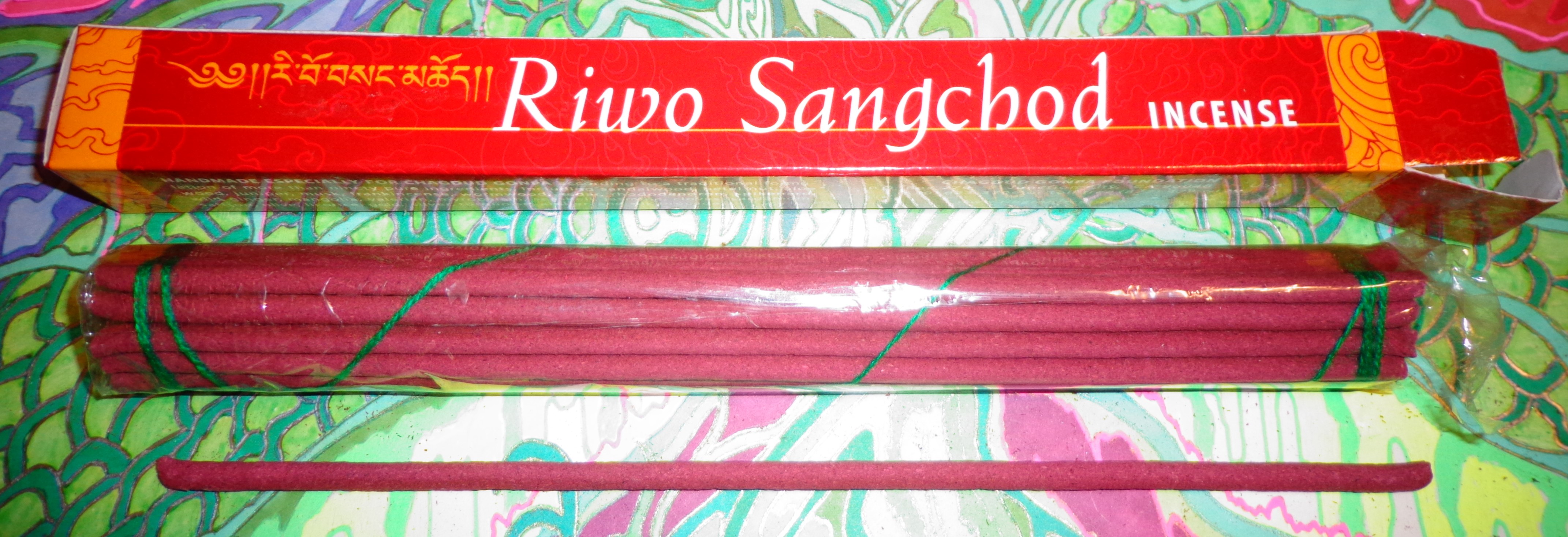
 Perhaps even more impressive than the Riwo Sangchod is Chagdud Gonpa Foundations’s
Perhaps even more impressive than the Riwo Sangchod is Chagdud Gonpa Foundations’s 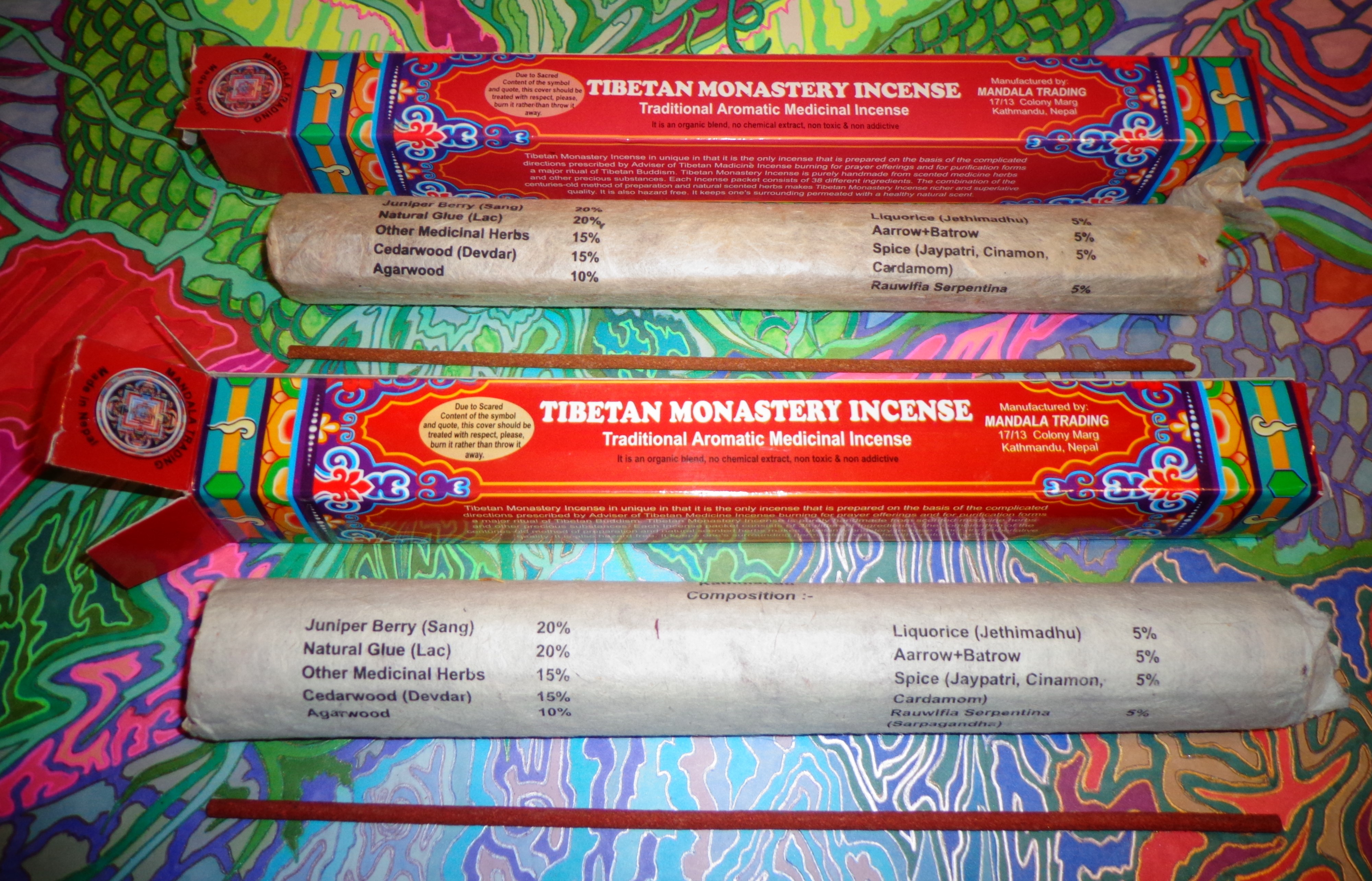 In terms of incenses, batch variation is always an issue with incenses of all different types and I will try to share changes in these when I have hard evidence. I’ve always felt that two of the best Nepalese incenses are the Himalayan Herbal and Tibetan Monastery incenses from Mandala Trading, they are available in many shops in the US that sells Tibetan incenses. I reviewed these both a little over 15 years ago. Before restarting ORS a few years ago I purchased the top box from Sensia. I was disappointed with the aroma at the time, it wasn’t quite what I remember and as in most cases it just gets kind of pushed to the back of my mind. One expectation that you can have is that an incense can change and never come back again, or at least for sure this is true in incenses with rare ingredients in them: sandalwood, aloeswood, halmaddi etc. While I’m not sure I could have explained the difference here, especially in that the inner wrapper has the ingredients actually listed, the ingredients appear to both be virtually identical.
In terms of incenses, batch variation is always an issue with incenses of all different types and I will try to share changes in these when I have hard evidence. I’ve always felt that two of the best Nepalese incenses are the Himalayan Herbal and Tibetan Monastery incenses from Mandala Trading, they are available in many shops in the US that sells Tibetan incenses. I reviewed these both a little over 15 years ago. Before restarting ORS a few years ago I purchased the top box from Sensia. I was disappointed with the aroma at the time, it wasn’t quite what I remember and as in most cases it just gets kind of pushed to the back of my mind. One expectation that you can have is that an incense can change and never come back again, or at least for sure this is true in incenses with rare ingredients in them: sandalwood, aloeswood, halmaddi etc. While I’m not sure I could have explained the difference here, especially in that the inner wrapper has the ingredients actually listed, the ingredients appear to both be virtually identical.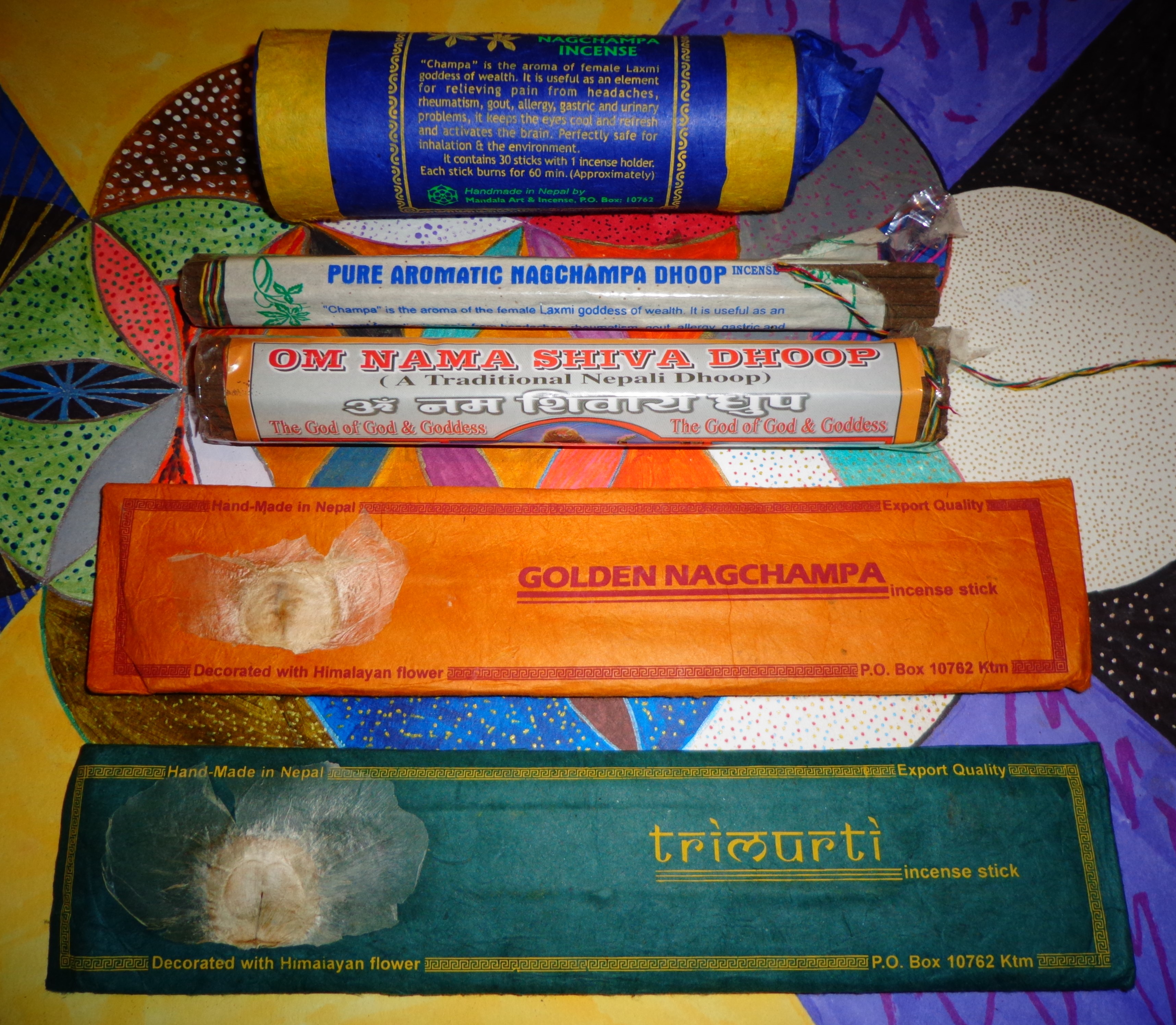 In addition to the Meena and other Indian incenses Everest Traders sent over, they also sent over a quintet of Nepali incenses. Since Essence of the Ages left the incense business, there has been a big hole where a solid source used to be for these incenses, as incensetraditions.ca carries primarily Tibetan and Bhutanese incenses only. Hither and Yon seems to be the primary source for Nepali incenses these days (note as always that “Tibetan” is also used as a style in the sense it means incense that does not use bamboo sticks through the middle, a distinction I need to make for later in this writeup) and there are a few others, but we’re always interested in hearing about new sources.
In addition to the Meena and other Indian incenses Everest Traders sent over, they also sent over a quintet of Nepali incenses. Since Essence of the Ages left the incense business, there has been a big hole where a solid source used to be for these incenses, as incensetraditions.ca carries primarily Tibetan and Bhutanese incenses only. Hither and Yon seems to be the primary source for Nepali incenses these days (note as always that “Tibetan” is also used as a style in the sense it means incense that does not use bamboo sticks through the middle, a distinction I need to make for later in this writeup) and there are a few others, but we’re always interested in hearing about new sources.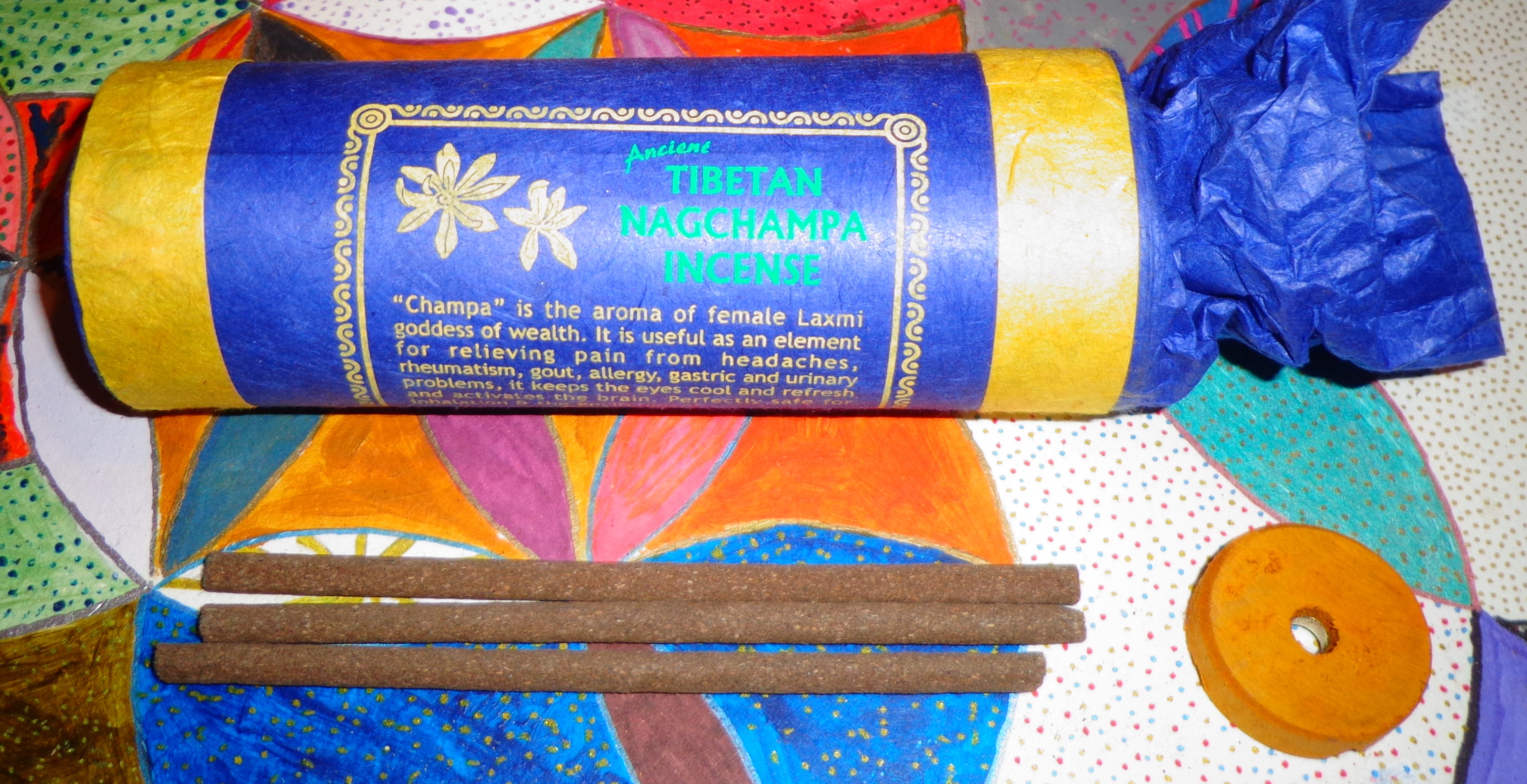 And it was interesting in looking around a bit that the first incense that pops up at Hither and Yon is Mandala Art & Incense’s
And it was interesting in looking around a bit that the first incense that pops up at Hither and Yon is Mandala Art & Incense’s  So how does the Natural Nepali Dhoop
So how does the Natural Nepali Dhoop  So in order to properly review Traditional Nepali Dhoop Pvt. Ltd.’s Om Nama Shiva Dhoop (I could not find an ebay link to this at present, but will add when I’m made aware of it) I thought it worth queueing up the great
So in order to properly review Traditional Nepali Dhoop Pvt. Ltd.’s Om Nama Shiva Dhoop (I could not find an ebay link to this at present, but will add when I’m made aware of it) I thought it worth queueing up the great 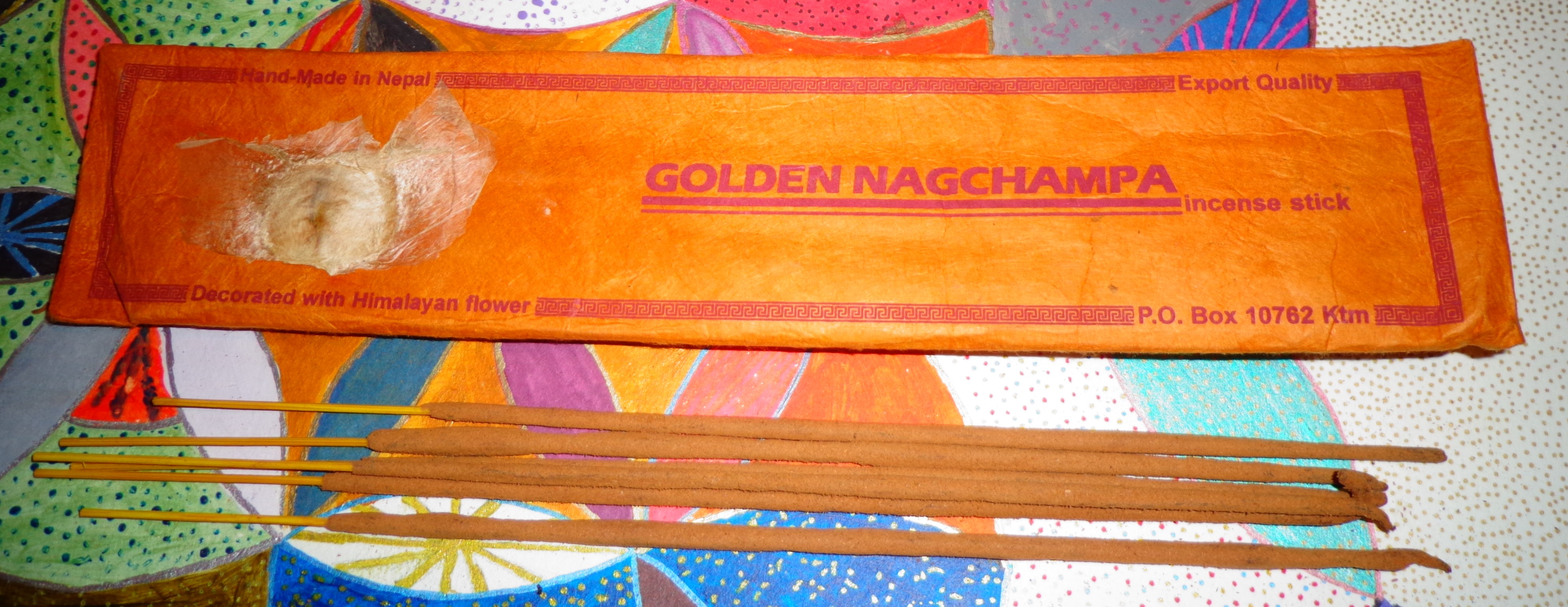 Moving to the
Moving to the  The issue with Trimurti and this is one ORS staff discuss a lot is that when incenses are named after religious or spiritual concepts, gods and goddesses etc, it can be tough to get a bead on what’s actually going on in the scent and so I’m limited in my description to say how successful the Trimurti is for what it’s trying to accomplish. From my perspective Trimurti barely gets past its base which is some sort of nebulous mix of evergreen woods. It’s also a bit spicy and I would guess there might be a bit of something like myrrh or gugal gum in the mix. What is perhaps missing and I can compare this to the Golden Nagchampa (which has it) is an intensity in aroma that makes it a bit more memorable and attention arresting. I do seem to remember the line was full of incenses like this. It may be entirely because the line is using 100% natural ingredients and not any sort of perfume wizardry, which would largely be in keeping with many Nepali incenses. But keep in mind as well if this is something you might recognize as an aroma you like you could feel differently from me.
The issue with Trimurti and this is one ORS staff discuss a lot is that when incenses are named after religious or spiritual concepts, gods and goddesses etc, it can be tough to get a bead on what’s actually going on in the scent and so I’m limited in my description to say how successful the Trimurti is for what it’s trying to accomplish. From my perspective Trimurti barely gets past its base which is some sort of nebulous mix of evergreen woods. It’s also a bit spicy and I would guess there might be a bit of something like myrrh or gugal gum in the mix. What is perhaps missing and I can compare this to the Golden Nagchampa (which has it) is an intensity in aroma that makes it a bit more memorable and attention arresting. I do seem to remember the line was full of incenses like this. It may be entirely because the line is using 100% natural ingredients and not any sort of perfume wizardry, which would largely be in keeping with many Nepali incenses. But keep in mind as well if this is something you might recognize as an aroma you like you could feel differently from me.
You must be logged in to post a comment.